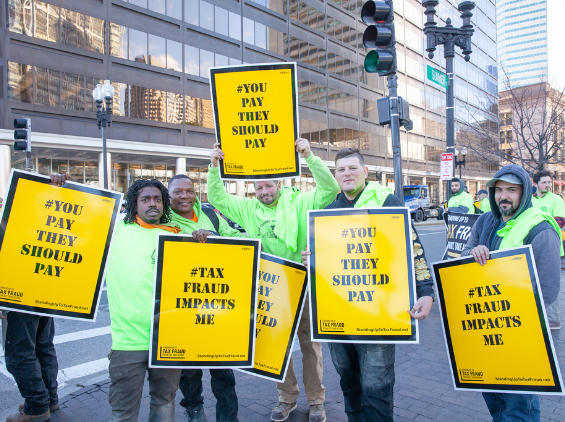A strong union needs skills, benefits and ACTION!

Tax fraud in the construction industry may be the single biggest threat to decent standards for carpenters throughout the United States and Canada.
That’s why around tax deadline day this year, union carpenters took to the streets to raise the profile on an issue that costs taxpayers more than $2.6 billion annually.
In our council, members gathered at more than twenty events of varying styles and sizes. But the message was clear and consistent: construction industry tax fraud is bad for workers, bad for honest contractors and bad for taxpayers.
Construction industry tax fraud usually consists of nonunion general contractors hiring subcontractors or layers of subcontractors and labor brokers who misclassify employees as independent contractors (1099s) or pay them in cash. The project, and everyone involved, gets illegal cost savings because taxes and workers’ compensation insurance aren’t paid, and contributions are not made to Social Security and unemployment.
“Union carpenters understand how rampant and dangerous this issue is
because so many experienced it firsthand before coming into the union or know unrepresented carpenters that are still dealing with it,” said Tom Flynn, Executive Secretary-Treasurer of the New England Regional Council of Carpenters.
“As carpenters, we see it throughout the industry, but most people don’t. We need to continue educating people about it and exposing the owners, developers and employers that make it a part of their business model.”
Workers lured into the scheme can’t collect unemployment when they get laid off. Their Social Security benefits will be significantly reduced, if they have any at all. If they get hurt on the job, they face significant health care costs because they have no benefits and aren’t covered by workers’ compensation. As if all of that weren’t enough, they’re also much more likely to have to deal with bouncing payroll checks or outright wage theft.
David Villanueva is an unrepresented worker who routinely dealt with the construction industry tax fraud. He shared his perspective in a NERCC video pushed out as part of the lead up to Tax Day events. “There were several cases when I didn’t get paid or I’d get paid at the end, but they always took [kept] part of the money,” Villanueva said. “If they owed me a thousand dollars, just to settle, they would come up and offer $600 or $700 and I would take it because I needed the money.”
While the collective bargaining agreement and jobsite stewards protect union carpenters, the issue isn’t strictly a union-nonunion issue, either. Nonunion contractors who carry their crews on the books and pay them properly are negatively impacted as well. They and their crews lose work when forced to bid against cheaters.
“Numbers don’t lie,” says John Anderson of Plumb House, an established nonunion wood frame subcontractor. “If we’re bidding a job and our labor number is 50% high, we know they can save 35% by not paying any insurance and paying people cash. If they are that much cheaper, we won’t even talk to the developer because that is a recipe for disaster.”
Anderson said there are too many contractors looking to exploit the workforce, but it’s the developers who really drive the scheme.
“Most often, it’s the developer. They just want the cheapest price and they don’t really care what happens. If that continues, it’s not going to be a Iot of fun being a general contractor.”
Why should anyone care? Because the $2.6 billion that isn’t being paid into federal and state taxes, increases the burden on everyone else. It stays in the pockets of crooked employers instead of being used to build roads, bridges and schools or fund police, fire or veteran services. It also reduces the likelihood of balancing budgets or allowing for tax cuts. There’s also a long-term cost for America.